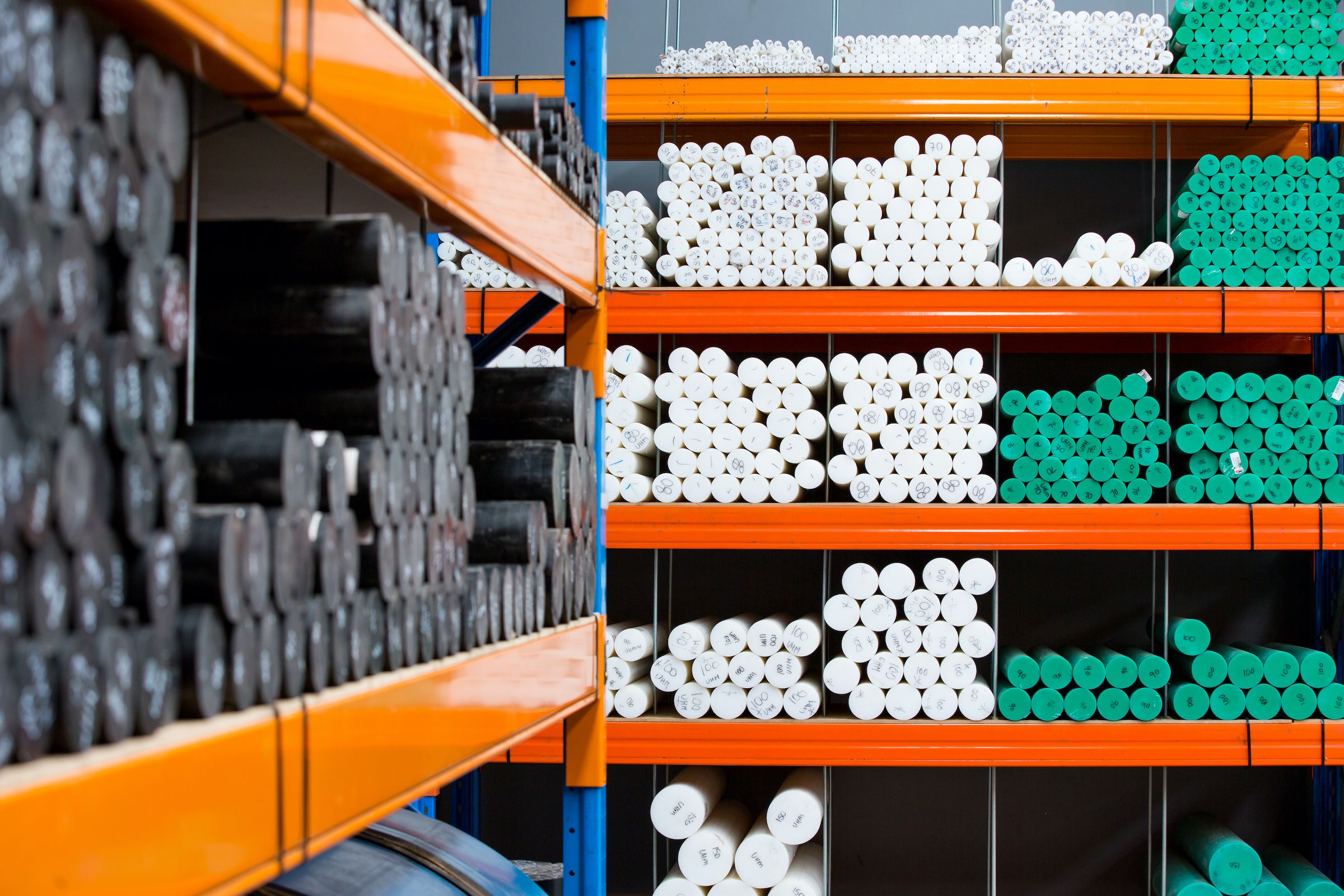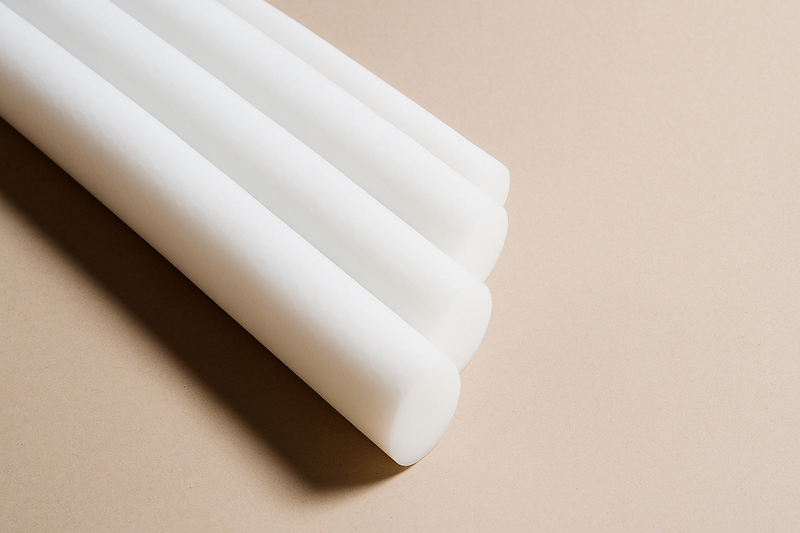At a glance
- Polycarbonate is known for its impact resistance and optical clarity, which makes it great for safety shields and optical components.
- Each plastic has its own strengths. Nylon is better for moving parts, Acetal is great for low-friction applications, and HDPE offers cost-effective durability.
- Choosing the right material relies on factors like strength, cost, and environment. This ensures long-lasting and safe performance.
Engineering plastics are crucial in industries such as healthcare, construction, manufacturing, and the automotive industry. Unlike regular plastics, they are designed to perform under stress. They offer superior dimensional stability and resistance to heat, chemicals, and wear. This makes them ideal for applications where reliability and safety are essential.
One standout among these materials is polycarbonate (PC). This high-performance plastic is known for its exceptional impact resistance, natural transparency, and ability to handle high temperatures. It is commonly used in products like safety helmets, machine guards, greenhouse panels, and bulletproof glass.
In this article, we will compare polycarbonate with other popular engineering plastics. By examining differences in strength, applications, heat tolerance, and cost, you will gain a clear understanding of each material’s capabilities. This will help you decide when to choose polycarbonate and when another option might be a better fit for your project.
Differences Between Polycarbonate and Other Engineering Plastics
Understanding how polycarbonate compares to other engineering plastics helps in choosing the right material for each job. Each plastic has its strengths and weaknesses, making some better suited for specific applications. Here’s a closer look at how polycarbonate stacks up against other engineered plastics.
Polycarbonate vs Nylon
Nylon is highly durable with high strength and increased abrasion resistance. This means it is used in numerous applications for moving parts, such as gears and bearings.
Key Differences between Polycarbonate and Nylon:
- Impact Resistance: Polycarbonate manages heavy impacts better. Standard nylon is strong but not as resistant to impulsive force, though impact-modified grades can improve performance.
- Flexibility: Nylon sheets are more flexible, which helps absorb shocks in moving parts.
- Moisture Absorption: Polycarbonate absorbs minimal moisture and maintains dimensional stability in humid environments, whereas nylon tends to soak up water, which can impact performance and size.
- Applications: Nylon is used in moving or load-bearing components, whereas polycarbonate plastics are used for safety shields, protective covers, or lenses.
Polycarbonate vs Acetal (POM)
Acetal has a low-friction surface and low wear properties. This means acetal is also used for precision parts that have to move, like gears, conveyor parts, and mechanical fittings.
Key Differences between Polycarbonate and Acetal:
- Wear Resistance: Acetal performs well in sliding applications, while polycarbonate is not suited for continuous wear and movement.
- Chemical Resistance: Acetal plastics have better resistance to chemicals compared to polycarbonate.
- Strength: Polycarbonate has greater impact strength, making it a better choice for protective or structural parts.
- Applications: Acetal plastics are used for gears and conveyor systems, while polycarbonate plastics are used for enclosures, guards, and equipment that faces impact.
Polycarbonate vs Polytetrafluoroethylene (PTFE)
PTFE (Teflon) has extremely high heat and chemical resistance. It is often used for non-stick coatings, seals, gaskets and industrial applications that require low friction.
Key Differences between Polycarbonate and PTFE:
- Strength: Polycarbonate is much stronger and more resistant to impact, while PTFE is softer and less stiff.
- Chemical Resistance: PTFE performs excellently in terms of chemical resistance, far exceeding PC in harsh conditions.
- Heat Resistance: PTFE can withstand continuous service temperatures up to around 260°C, while PC has moderate heat tolerance of around 115–125°C.
- Friction: PTFE has an extremely low friction coefficient. In contrast, PC is not ideal for low-friction requirements.
- Applications: PC is used for protective covers, optical components, and safety equipment, whereas PTFE is used for seals and parts in chemical processing.
Polycarbonate vs UHMWPE
UHMWPE (Ultra High Molecular Weight Polyethylene) is a very high-performance plastic. It is one of the most durable engineering plastics and has excellent toughness. Due to its impact strength, it can resist heavy loads and repeated stress without cracking.
Key Differences between Polycarbonate and UHMWPE:
- Strength: UHMWPE has outstanding impact toughness and resists fracturing under heavy loads, while PC offers higher tensile strength and rigidity, making it better for structural and protective components.
- Wear Resistance: UHMWPE excels in abrasion resistance and sliding applications. In contrast, PC is not designed for continuous wear and tear due to friction.
- Chemical Resistance: UHMWPE has outstanding chemical and moisture resistance. It outperforms PC in harsh environments, except when exposed to strong oxidising acids.
- Heat Resistance: PC can tolerate higher temperatures (up to about 120°C) compared to UHMWPE (around 80°C continuous use).
- Transparency: PC is naturally clear and ideal for visual applications. Meanwhile, UHMWPE is opaque.
- Applications: PC is used for safety equipment, machine guards, and optical parts. UHMWPE is used for liners, gears, marine dock fenders, and food processing equipment.
Polycarbonate vs High-Density Polyethylene (HDPE)
Known for its balance of strength and flexibility, HDPE is a lightweight yet tough plastic. It is valued for its durability and strong resistance to moisture and many chemicals.
Key Differences between Polycarbonate and HDPE:
- Strength: HDPE is tough but more flexible, whereas PC is much stronger and more rigid, making it ideal for high-impact uses.
- Chemical Resistance: HDPE has strong chemical and moisture resistance, performing better than PC in environments with harsh chemicals.
- Transparency: PC is naturally clear and suitable for visual or optical uses, while HDPE is opaque.
- Cost: HDPE, while technically a high-performance commodity plastic, offers engineering-grade toughness at a much lower cost than PC.
- Applications: PC is used for protective shields and safety helmets. HDPE is used for piping, outdoor furniture, water tanks, and storage containers.
Choosing the Right Engineering Plastic
Each material has unique strengths, making it more suitable for specific applications. That's why selecting the right plastic depends on its intended use. Here’s a quick guide to help you decide the right plastic for your use case:
- Strength & Durability: When you need toughness and impact resistance, Polycarbonate plastics stand out. For heavy, load-bearing parts, Nylon offers long-lasting strength and resilience.
- Chemical Resistance: In environments with harsh chemicals or corrosive substances, PTFE or HDPE are the best choices due to their strong resistance.
- Transparency: For situations where visibility is crucial, such as safety shields, machine guards, or optical components, PC is the clear choice.
- Wear Resistance: For parts that need to slide or move smoothly, Acetal plastics and UHMWPE are excellent due to their low-friction and high wear resistance.
- Temperature & Environment: PTFE can operate at around 260°C, PC around 120°C, and UHMWPE around 80°C. PTFE and PC perform well in high-heat conditions, while HDPE and UHMWPE are ideal for outdoor use in damp or sunny environments.
- Cost vs. Performance: For top performance, choose PC or PTFE. If cost is a concern, HDPE is a more affordable yet reliable option.
Choosing the right engineering plastic is critical for product safety, performance, and longevity. Every material has its own unique benefits for a given application. It's essential to understand the differences and select the appropriate option that suits your needs. Whether you need impact resistance, chemical stability, or cost-effectiveness, there is an engineered plastic that will work for you.
Polycarbonate remains a top choice for industries that need a balance of strength, heat resistance, and optical clarity. However, materials like UHMWPE, PTFE, and HDPE excel in other areas, such as chemical or wear resistance.
Partner with a reliable engineering plastics supplier to access high-quality Polycarbonate sheets and ensure your projects are built to last. Explore ePOL’s online portal or contact our team for professional advice.
FAQs
Is polycarbonate better than nylon, ABS, or polypropylene for high-impact applications?
Yes, polycarbonate is much more impact-resistant than nylon, ABS, or polypropylene. It is a preferred material for products like safety helmets and machine guards where strength is essential.
What makes polycarbonate different from other engineering plastics?
Polycarbonate is unique for its toughness, heat resistance, and natural clarity. Unlike many plastics, it is both strong and clear, making it suitable for optical uses.
Which plastic should I choose for chemical resistance and outdoor use?
For environments with harsh chemicals or frequent exposure to moisture and sunlight, PTFE, UHMWPE, or HDPE are better options than polycarbonate because of their greater resistance to these conditions and durability.
Can polycarbonate be used in place of polyethylene or polypropylene in industrial projects?
Sometimes, polycarbonate is a good choice when strength and visibility are required. However, it cannot match the chemical resistance or flexibility of PE or PP. The best option depends on your project's specific needs.








